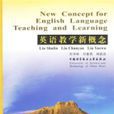基本介紹
- 書名:英語教學新概念
- 作者:劉書森
- ISBN:10位[7312017827] 13位[9787312017827]
- 定價:¥18.00 元
- 出版社:中國科學技術出版社
- 出版時間:2004-12-1

《新概念英語》是1997年由外語教學與研究出版社和培生教育出版中國有限公司聯合出版的一套英語教材。作為一套世界聞名的英語教程,以其全新的教學理念,有趣的課文...
《英語教學新概念》是2004年中國科學技術出版社出版的圖書,作者是劉書森。該書在梳理和介紹英語教學的新理念和趨勢的基礎上,提出了新型的英語教學模式——建構主義...
《新概念英語》是1997年10月外語教學與研究出版社出版的一本圖書,作者是(英)亞歷山大(L.G.Alexander)、何其莘。該書完整的講述了英語學習體系。...
《新概念英語青少版》是“新概念英語”教學體系的新成員,由世界著名英語教學專家路易·亞歷山大、朱莉婭·亞歷山大和羅伊·金斯伯里專為中國8-14歲的青少年以及英語...
《新概念英語4》是1997年外語教學與研究出版社出版的圖書,作者是亞歷山大、何其莘。《新概念英語4》主要內容包括《新概念英語》是世界聞名的英語教程。本版是《新...
《新概念英語3》是該教材首次出版以來第一次推出的新版本。這套經典教材一如既往地向讀者提供一個完整的、經過實踐檢驗的英語學習體系,使學生 有可能在英語的四項...
《新概念英語1:黃金教案》的辭彙、句型和語法的學習向來是學習者學習《新概念英語》的必由之路。宋德偉、顧玉梅等著的《新概念英語1:黃金教案》緊扣原教材,每課...
《新概念英語2》是2009年7月外語教學與研究出版社出版的圖書,作者是何其莘、張衛晴。本書是一套經典的英語教程,是學習英語的輔導用書。...
《新概念一冊》是外語教學與研究出版社出版的圖書,作者是亞歷山大(L.G.Alexander)、何其莘。《新概念一冊》是《新概念英語》系列中的第一本。原作者為路易·...
《新概念英語3新版》是1997年10月外語教學與研究出版社出版的圖書,作者是亞歷山大、何其莘。...
《新概念英語課堂筆記》是2009年中國石化出版社出版的圖書,作者是新概念英語學習中心編。本書主要內容包括課文重點語句注釋、核心語法點精講及課後習題參考答案。...
《新概念英語》(新版)是《新概念英語》1967年首次出版以來第一次推出的新版本。由該經典教材的出版者外語教學與研究出版社和培生教育出版北亞洲有限公司獨家授權、...
《新概念英語(1)》是1993年上海世界圖書出版公司出版的圖書,作者是L.G.Alexander。...... 亞歷山大,L.G.Alexander,世界著名的英語教學權威,曾任歐洲現代語言學者...
《新版新概念英語1》是2009年6月1日西安交通大學出版社出版的圖書。本書通過集作者十年新概念英語教學精粹,結合中學部骨幹教師多年高中,國中教學經驗,適合各層次...
高效新概念英語是一款軟體套用,適合mobile平台,軟體版本為1.0。...... 高效新概念英語是一款軟體套用,適合mobile平台,...我們經過多年英語教學實踐的摸索,發明了最簡...
《新概念英語自學導讀》是2002年外語教學與研究出版社出版的圖書,作者是孫玉榮、杜建。本輔導叢書涵蓋自學導讀、練習詳解、辭彙、語法以及錄音練習等各方面的內容,是...
《新概念英語(2)》是1997年10月由外語教學與研究出版社出版的圖書,作者是亞歷山大。本書適合完成初級水平英語學習的成年學習者和中學生使用。...
《新概念英語三冊》是1997年10月外語教學與研究出版社出版的一本書籍。作者是L.G. Alexander,何其莘。本書主要是一套英語教程。...
《新概念英語(國中版)》是2011年出版的圖書,作者是董志翔。...... 《新概念英語(國中版)》是2011年出版的圖書,作者是董志翔。作者 董志翔 ISBN 9787513508834 ...
套用介紹 新概念英語是由外語教學與研究出版社和培生教育出版中國有限公司聯合出版的一本,關於英語學習的指導書。包含聽、說、讀、寫部分。本版本新東方新概念英語...
《新概念英語經典全套裝》為外語教學與研究出版社製作的又一個大盒裝產品,套裝中包含已出版的《新概念英語》系列學生用書、練習冊、自學導讀和練習詳解,並附有語法...
《英語新概念閱讀(第五冊)》是2004年上海外教出版的圖書,作者是巴頓 。...... 《英語新概念閱讀(第五冊)》是2004年上海外教出版的圖書,作者是巴頓 。...
套用介紹 新概念英語青少版視頻教程針對青少年的身心特點,採用了和他們生活、學習密切相關的語言材料。精心設計的聽力、口語、閱讀和寫作練習幫助青少年紮實地掌握各項...
《新概念英語練習詳解1》是2001年外語教學與研究出版社出版的圖書,作者是何其莘。...... 《新概念英語練習詳解1》是2001年外語教學與研究出版社出版的圖書,作者是...
《新概念英語自學導讀3》是外語教學與研究出版社2001年1月1日出版的圖書,作者是孫玉榮、杜建。本書是中國廣大英語愛好者的一套權威的輔導用書,可以滿足中國廣大...
《新概念英語:一課一練1》是2006年03月航空工業出版社出版的圖書,作者是李正栓。本書是針對《新概念英語》所設計的練習,是一本優秀的英語學習工具書。...
